
Size
2.4 inches
Physical characteristics and behavior
There are 8–10 total dorsal soft rays. The middle of the ventral surface of the caudal peduncle lacks a prominent line of black pigment. In SL, the deepest part of the body may be nearly twice as deep. The caudal fin’s ventral rays are not developed into a sword form in males. Males lack a membrane protuberance, have a strong hook on the third ray, and have gonopodium that does not extend to the base of the caudal fin.
Habitat
The aquarium should be 80 gallons in size, densely planted, and kept between 20 and 26 degrees Celsius for the platy fish to thrive. The pH of the water must remain between 7 and 8.2.
As Pet

- Tank and Habitat Requirements
In the natural, platy fish live in marginal bodies of water like ponds, backwaters, marshes, and ditches. These warm, slow-moving, somewhat hard, and heavily vegetated bodies of water.
Although platy fish are tough and can adapt to a variety of water conditions, a biotope tank aids in their growth and prolongs their lifespans when kept in captivity.
- Feeding
Fish with plates are omnivores. The food that platy fish consume in the wild includes algae, plants, tiny crustaceans, and insects. The coloring of platy fish is improved by a vitamin-rich diet.
Platies don’t have preferences, although they thrive on a diet high in quality flakes and veggies. The best vegetables are lettuce, cucumber, and spinach. Feed frozen and live items from time to time, including tubifex, brine shrimp, and bloodworms. In the tank, platies graze on algae. Give platy fish only as much as they can consume in three minutes. Give adult platy fish one or two meals each day. Feeding young platy fish frequently is necessary.
- Tank Mates
Peaceful, comparable-sized species that won’t bother the platy fish make the greatest tank mates. Corydoras, Crabs, Danios, Gouramis, Guppies, Mollies, Shrimps, Snails, Swordtails, and Tetras are a few of these.
- Conditions of Tank
The following tank settings are suitable for platy fish:
- Water Type: Freshwater, with every two weeks a 25%–30% water change.
- Tank Size: Minimum 10 gallons in size are required for a school of five to six platy fish. Add 2 gallons for every extra fish. Platy fish need a roomy, lengthy tank because they are energetic swimmers.
- Water temperature: 21–25 °C (70–77 °F).
- Substrate: Any substrate will do as a substrate. Because they don’t frequently swim at the bottom, platy fish aren’t particular about the substrate. Sand with a dark colour enhances the hues of platy fish.
- Tank setup: The tank should have vegetation and plenty of room for platy fish to swim around and burn off energy. Because platy fish can jump out of the tank, it’s crucial to have a tight tank lid.
- Acidity: Platy fish like an alkaline pH level for their water. Maintain a pH between 6.8 and 8.0.
- Water Hardness: Choose a water hardness of between 10-28 dGH. In the natural, platy fish are accustomed to harsh water.
- Filter: The tank’s cleanliness and ammonia and nitrate levels are maintained by filtration. Avoid filters that generate powerful currents. Platy fish are used to swimming in still water.
- Bubbler: Not necessary if the tank is big.
- Lighting: Daytime lighting is moderate. To simulate a day-to-night cycle, keep the lights dim at night. Don’t use harsh lighting
- Plants: Plants offer hiding places and enhance the comfort of platy fish. Plants ought to be resilient and capable of withstanding identical water circumstances. The best plants include java moss, duckweed, and hornwort. Because platy fish prefer to swim at the surface, floating plants are effective.
Table





